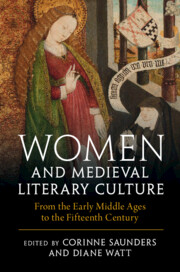Book contents
- Women and Medieval Literary Culture
- Women and Medieval Literary Culture
- Copyright page
- Contents
- Illustrations
- Contributors
- Acknowledgements
- Introduction
- I Patrons, Owners, Writers, and Readers in England and Europe
- II Circles and Communities in England
- III Health, Conduct, and Knowledge
- IV Genre and Gender
- Chapter 11 Lyrics
- Chapter 12 ‘It satte me wel bet ay in a cave / To bidde and rede on holy seyntes lyves’
- Chapter 13 Tears, Mediation, and Literary Entanglement
- Chapter 14 Convent and City
- Chapter 15 Women and Romance
- Chapter 16 Trouble and Strife in the Old French Fabliaux
- Chapter 17 Chaucer and Gower
- V Women as Authors
- General Index
- Index of Manuscripts
- References
Chapter 11 - Lyrics
Meditations, Prayers and Praises; Songs and Carols
from IV - Genre and Gender
Published online by Cambridge University Press: 28 July 2023
- Women and Medieval Literary Culture
- Women and Medieval Literary Culture
- Copyright page
- Contents
- Illustrations
- Contributors
- Acknowledgements
- Introduction
- I Patrons, Owners, Writers, and Readers in England and Europe
- II Circles and Communities in England
- III Health, Conduct, and Knowledge
- IV Genre and Gender
- Chapter 11 Lyrics
- Chapter 12 ‘It satte me wel bet ay in a cave / To bidde and rede on holy seyntes lyves’
- Chapter 13 Tears, Mediation, and Literary Entanglement
- Chapter 14 Convent and City
- Chapter 15 Women and Romance
- Chapter 16 Trouble and Strife in the Old French Fabliaux
- Chapter 17 Chaucer and Gower
- V Women as Authors
- General Index
- Index of Manuscripts
- References
Summary
This essay explores the ways in which the genre of medieval lyric illuminates womenߣs literary culture. Lyrics offer insights into attitudes to women and creative engagements with gender; sacred lyrics find special inspiration in the figure of the Virgin Mary. As Fuller shows, straightforward readings are likely to be simplistic: lyrics may both speak vividly to female readers and seem distanced from the lives of actual women; the context of virginity may be as relevant to male as female religious readers; and lyrics may address complex theological questions. Romance conventions are taken up in secular lyrics, as are conventions familiar from fabliau and anti-feminist satire: women speakers are repeatedly used to voice male stereotypes. Finally, the essay demonstrates the challenges of reading the womanߣs voice in relation to the ߢFindernߣ manuscript, a fifteenth- and early sixteenth-century provincial miscellany which includes the names of five women, who, it has been argued, composed and copied a number of the lyrics written in it. Fuller demonstrates that the manuscript raises complex questions concerning the relationship between art and life which resonate across the genre.
- Type
- Chapter
- Information
- Women and Medieval Literary CultureFrom the Early Middle Ages to the Fifteenth Century, pp. 229 - 249Publisher: Cambridge University PressPrint publication year: 2023

